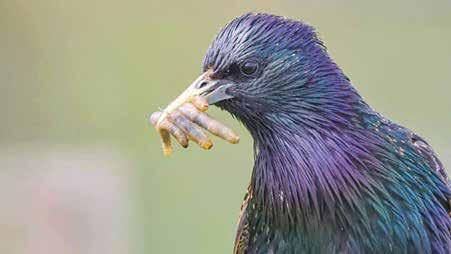
2 minute read
Nature plays a role
The phrase integrated pest management is used a lot, and here Dr Marie Athorn from the RSPB and R&A partnership talks about how nature might play a role in helping.
Legislative reduction of pesticide use is affecting golf course management across the UK. These changes are vital to protect our environment. So, let’s discuss how nature can help you reduce some of the pressure and damage that pests might cause. Several species considered as pests on golf courses are actually food sources for a range of species in the UK.
One of those species is Starlings. Starlings feed on leatherjackets, especially during the breeding season. They need to feed their chicks something juicy! Starlings have small thin beaks and so, when they feed on leatherjackets in greens or tees, they don’t leave damage. Starlings have declined by 82% in the last few decades, they are however still widespread in the UK, albeit in much smaller numbers. Starlings take well to bird boxes that are designed for them. Putting Starling boxes up around your golf course means that the Starlings that use them will hopefully feed on the leatherjackets on your golf course. So, by helping Starlings have somewhere to nest, you may also help your own cause.
Monitoring
Adults
Monitoring and recording when adults of each pest species are active will help to show the severity and distribution of the pests and when to begin monitoring for the larvae.
Chafer beetles can be monitored using a chafer pheromone trap.
Use a sweep net or visual monitoring to estimate numbers and establish distribution of crane fly (adult leatherjackets).
In subsequent years the amount of adult activity could be used as a reference for likely larval levels.
Several bat species also feed on crane flies. They will feed over habitats that attract insects, so if you can manage areas of woodland, grassland and wetlands naturally, this will attract bats to feed on your golf course. Bats will roost in natural cavities in trees, so try and retain trees with natural cavities like cracks and rot holes, or why not make and put up bat boxes across your golf course. Do remember though, bats are protected - once the bat box is up and being used, it would need a licensed person to advise before you can move it – so think carefully about where you place them!
Larvae
Monitoring of larval numbers and distribution can be used to determine when action thresholds have been reached and economic or aesthetic damage is likely if appropriate action is not taken.
Using a hole cutter, remove soil samples from several locations within each area that is being monitored. Alternatively, use plastic sheeting overnight to encourage the larvae to the surface. To ensure that a representative view of the area is obtained, use a standardised methodology such as walking a W-shaped transect or use a grid system to sample at regular distances.










